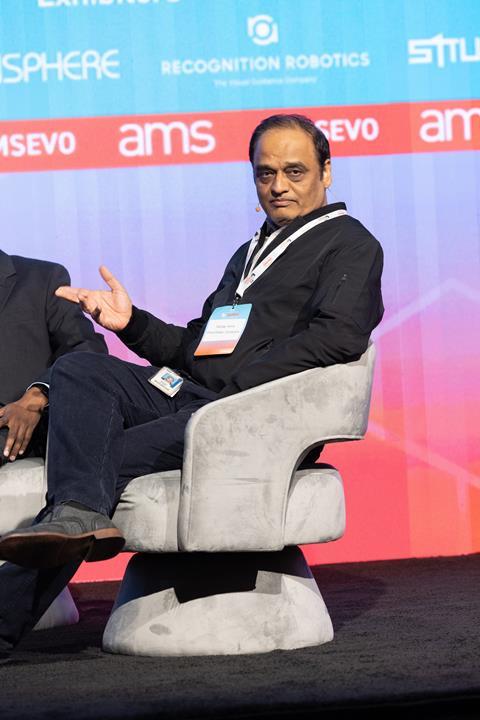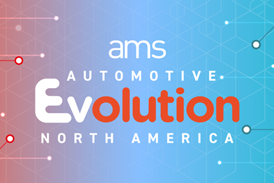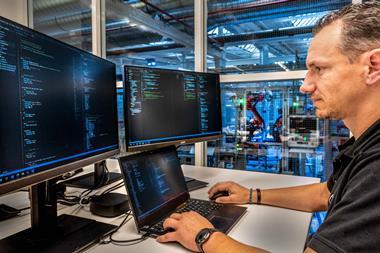The concept of the smart factory offers highly efficient, optimised production operations. Ford, ZF and PPG reveal how they are working to realise this potential.
The rise of smart factories is reshaping how vehicles are designed, manufactured, and delivered to consumers. These advanced manufacturing facilities leverage cutting-edge digital technologies such as artificial intelligence (AI), machine learning, and data analytics to streamline operations and improve production efficiency. However, while the potential benefits of smart factories are undeniable, the path to realising them is fraught with challenges, ranging from data management hurdles to workforce transformation needs.
“We have a data engineering team responsible for creating data products by combining multiple data sources. This ensures that any data about a product or process is accessible in one place” – Rajeev Kalamdani, Ford
Automotive manufacturers such as Ford, ZF and PPG are developing strategies to integrate smart factory principles into their operations. These companies are balancing investments in technology with initiatives to upskill their workforce and foster collaboration.

Data as the backbone of smart factories
In the world of smart factories, data is more than just an asset; it is the foundation upon which all advanced operations are built. The ability to collect, integrate, and analyse data effectively determines the success of a smart factory. Without a robust data infrastructure, even the most advanced technologies cannot function optimally.
Ford Motor Company has taken a significant step in this direction with its “Manufacturing 360” system, which centralizes data from various sources to provide a unified view of operations. According to Rajeev Kalamdani, Manager of IIoT Analytics at Ford, “We have a data engineering team responsible for creating data products by combining multiple data sources. This ensures that any data about a product or process is accessible in one place.” By consolidating information into a single system, Ford can enhance decision-making, optimise production flows, and ensure consistency across its operations.
“There’s plenty of data, but it’s spread across departments. Accessing and centralising this information is a major bottleneck” – Steve Phillips, PPG

However, achieving this integration is not easy. Many manufacturers struggle with siloed data systems that prevent seamless communication between departments and processes. Steve Phillips, Global Digital Applications Manager at PPG Coatings, explains, “There’s plenty of data, but it’s spread across departments. Accessing and centralising this information is a major bottleneck.” Addressing this issue requires significant investment in technologies like cloud-based systems and data integration platforms that facilitate seamless data sharing.
Equally important is ensuring the accuracy and reliability of the data collected. Faulty sensors, manual data entry errors, and inconsistent formats can all compromise the quality of insights derived from analytics. Phillips emphasises the need for rigorous data quality checks: “Manual data entry errors, faulty sensors, or misplaced decimal points can skew analysis. Without clean, accurate data, even the best tools will fail.” To mitigate these risks, manufacturers are implementing strict governance protocols and employing certified data providers to ensure the integrity of their datasets.
Data management is not just about overcoming challenges; it is also about unlocking opportunities. Centralised and reliable data systems allow manufacturers to implement advanced analytics, predictive models, and real-time monitoring, all of which contribute to creating a smarter, more efficient factory environment.
Watch our video interview with ZF’s Fernando Bera ZF speaking at this year’s Automotive Evolution conference in Detroit
The role of advanced digital tools
Smart factories rely on a suite of digital tools to enable the integration, automation, and optimisation of production processes. From digital twins to predictive maintenance, these technologies are transforming the automotive manufacturing landscape and driving significant gains in efficiency and quality.
“Manufacturing digital twins can eventually replace MES, FIS, and even SCADA systems” – Raj Sohmshetty, Wayne State University

Digital twins are a powerful tool in the smart factory arsenal. These virtual replicas of physical assets allow manufacturers to simulate and optimise processes in a risk-free environment. “Manufacturing digital twins can eventually replace MES, FIS, and even SCADA systems,” says Raj Sohmshetty of Wayne State University. By providing a detailed, real-time view of operations, digital twins help manufacturers identify bottlenecks, test new strategies, and predict potential issues before they occur.
Predictive maintenance is another critical application of smart factory technology. By monitoring equipment conditions in real time, manufacturers can identify and address potential failures before they lead to costly downtime. At Ford, this approach has become a cornerstone of their operations. Kalamdani explains, “We are moving from cycle-based to condition-based maintenance. Sensors enable real-time monitoring, allowing us to alert operators ahead of potential failures.”
PPG Coatings is also leveraging advanced technologies to enhance quality control. The company employs defect vision systems that use heat mapping and clustering algorithms to pinpoint issues on the production line. “Defect vision systems allow us to identify problems – such as tilted conveyors – quickly and cost-effectively,” Phillips explains. This proactive approach not only prevents defects from escalating but also reduces waste and improves overall product quality.
Real-time analytics further enhance the capabilities of smart factories by enabling manufacturers to respond to issues as they arise. In Ford’s paint shops, for example, real-time film build measurements allow operators to address inconsistencies immediately, preventing defects from affecting subsequent processes. “We use real-time measurements to save costs and ensure consistent quality,” notes Kalamdani.
While these tools offer immense potential, their implementation requires careful planning and significant investment. Manufacturers must balance the integration of advanced technologies with the need to maintain operational stability, ensuring that new systems enhance rather than disrupt existing processes.

Workforce: The human element of smart factories
While technology is the backbone of smart factories, people are the driving force behind their success. Transitioning to a smart manufacturing environment requires a workforce that is not only skilled in using advanced tools but also adaptable to the rapid pace of technological change.
“Technology alone isn’t enough. People are the most important part of this puzzle,” says Fernando Bera, Engineering Supervisor at ZF Transmissions. “The key is to combine their expertise with advanced tools to create meaningful solutions.” This perspective underscores the importance of workforce engagement in the smart factory journey.
To prepare employees for the demands of smart manufacturing, companies are investing heavily in training and upskilling programs. These initiatives aim to equip workers with the technical skills needed to operate, maintain, and optimize new systems. At Wayne State University, for instance, year-long internships provide students with hands-on experience in real-world manufacturing challenges. “These programs bring fresh perspectives and help students gain practical experience with cutting-edge technologies,” says Sohmshetty.
“Our interns are incredibly fast and innovative. By challenging them with real problems, we see solutions delivered in days rather than weeks” – Fernando Bera, ZF
Younger workers, particularly interns, are playing a pivotal role in driving innovation within smart factories. ZF Transmissions has embraced this approach, leveraging the technical skills and enthusiasm of its interns to tackle complex problems. Bera highlights their contributions: “Our interns are incredibly fast and innovative. By challenging them with real problems, we see solutions delivered in days rather than weeks.”

Collaboration across departments is another critical aspect of workforce engagement. Cross-functional teams ensure that smart factory solutions are designed with input from all relevant stakeholders, improving both the quality of the solutions and their adoption. Sanjay Ahire, a data scientist at Ford, points out, “Solutions won’t fly unless there’s a strong requirement and someone ready to adopt them. Collaboration ensures ideas don’t just remain in development but are put into practice.”
By fostering a culture of continuous learning and collaboration, manufacturers can ensure that their workforce remains a vital asset in the transition to smart factories.
Balancing innovation with stability
One of the most significant challenges in implementing smart factory technologies is maintaining a balance between innovation and operational stability. While advanced tools and systems promise substantial benefits, their introduction can disrupt existing workflows if not managed carefully.
“You need to filter the operational noise from strategic goals,” says Bera. “It’s a delicate balance between managing day-to-day operations and driving digital innovation.” Manufacturers must adopt a phased approach to implementation, starting with small-scale pilot projects before scaling up to full production. This strategy allows companies to test new systems in a controlled environment, identify potential issues, and refine their solutions before rolling them out across the organisation.
“By implementing solutions that save 10 minutes per vehicle during a specific task, we calculated cost savings by multiplying time saved by the hourly rate. It’s incremental improvements like these that build the case for digital transformation” – Rajeev Kalamdani, Ford
Another critical consideration is the return on investment (ROI) for smart factory projects. Justifying the costs of digital transformation can be challenging, particularly for long-term initiatives that may not yield immediate results. Kalamdani explains how Ford approaches ROI: “By implementing solutions that save 10 minutes per vehicle during a specific task, we calculated cost savings by multiplying time saved by the hourly rate. It’s incremental improvements like these that build the case for digital transformation.”
Despite these challenges, the potential benefits of smart factories—enhanced efficiency, reduced waste, improved quality, and greater flexibility—make them a compelling investment for automotive manufacturers.
A glimpse into the future
As the automotive industry continues to evolve, smart factories will play an increasingly central role in shaping the future of manufacturing. With advancements in AI, digital twins, and IoT, manufacturers are poised to achieve unprecedented levels of efficiency, flexibility, and sustainability.
Phillips envisions a future where quality improvements drive throughput gains: “The idea is to improve quality through data, which will naturally improve throughput. With predictive analytics and historical data, we can identify potential issues before they occur, saving time and resources.”
Sohmshetty echoes this sentiment, emphasising the long-term benefits of building comprehensive digital ecosystems: “Every time we solve a problem, we add to the digital twin. Over time, this cumulative knowledge creates a manufacturing system that’s smarter, faster, and more resilient.”
For organisations like Ford, ZF and PPG, the journey to smart factory success is as much about people as it is about technology. By fostering a culture of collaboration, investing in workforce training, and embracing innovative solutions, these companies are setting the standard for the future of automotive manufacturing.
As the industry continues to embrace the principles of smart factories, the promise of a more agile, efficient, and sustainable manufacturing landscape grows closer to reality.







































No comments yet